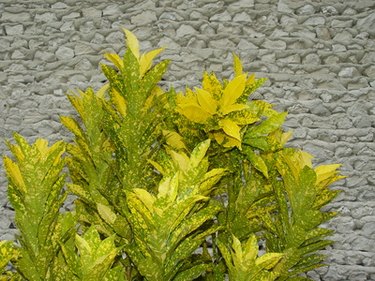
The brilliant colors of the croton (Codiaeum variegatum) make it a bright addition to landscape plantings in frost-free gardens in U.S. Department of Agriculture plant hardiness zones 9b through 11. To avoid croton frost damage in cooler climates, grow these tropicals in containers and take them indoors when temperatures drop below 50 degrees Fahrenheit.
Growing Crotons Outdoors
Video of the Day
Native to India and Malaysia, crotons range in size from 3 to 10 feet tall or more. When growing your crotons in the garden, plant them in a well-drained, organically rich soil. The plants prefer a pH level between 4.5 and 6.5. While crotons thrive in full sun, most tolerate part sun and light or dappled shade.
Video of the Day
Space your crotons 2 to 4 feet apart according to the mature size of the plant so that the large leaves have room to spread out. Plant them at the same depth as they were in the grower's pots. Water regularly when the soil is dry to a depth of 1 to 3 inches. Once established, crotons are somewhat drought resistant.
Fertilize crotons with a slow-release 3-1-2 fertilizer. Scratch the fertilizer granules over the soil and then water thoroughly. Add a 3- to 4-inch layer of mulch around the plants, pulling it back 3 inches from the crotons' stems.
Protecting Crotons From Freezing Temperatures
A sheltered, south-facing wall that receives plenty of sun provides a warm microclimate that may save your crotons if temperatures drop to freezing. Water thoroughly to hydrate the plants. Build a temporary structure or install stakes to hold frost blankets, fabric or plastic sheeting above the foliage and cover your crotons before temperatures drop to the 30s. Weigh down the edges with bricks or rocks to prevent cold air from seeping under the covering.
One or two 100-watt lights designed for exterior use can increase the temperature under the covering by several degrees. Don't let the hot bulbs touch the foliage or covering. Use a GFCI-protected outlet to prevent electrical shocks. Turn off the lights and uncover the plants when the sun comes out and temperatures rise.
Alternatively, plant crotons in large containers and take them indoors before winter arrives. A sunny window or sunroom provides plenty of light. Group plants together or add a cool-steam vaporizer to increase the humidity in the air. Mist regularly and wipe the leaves with a damp cloth to discourage and remove pests.
Collecting Colorful Croton Types
Plant breeders have developed several hundred cultivars that feature a wide range of colors and variegations, heights ranging from dwarf to tall enough for a privacy hedge and lower-light tolerances. Leaf shapes may be long and straplike, large and oval or irregularly shaped with lobed edges. Leaves may be variegated, spotted or green with colorful veins.
If you're looking for a dwarf croton, consider 'Mammy,' also known as 'Fire,' which features narrow leaves in vibrant yellow, orange, peach, red and/or burgundy plus green in a wild array of color combinations on the 3-foot-tall plant.
Green and yellow cultivars include 'Gold Dust,' 'Mother and Daughter' and 'Eleanor Roosevelt,' while 'Petra,' 'Magnificent' and 'Zanzibar' add splashes of pink to red to the color scheme. These cultivars grow up to 7 feet tall under ideal conditions. For a really big croton that sports gold, orange or deep-red veins on its green leaves, consider planting 'Red Iceton.' At up to 20 feet tall, it is suitable as a backdrop for smaller croton types or as a bright focal point amid the hardier plants in your tropical garden.
Protecting Yourself From the Sap
While crotons are easy to grow, put on safety goggles and gloves before handling, moving or trimming your plants. Crotons ooze a milky latex sap that is an irritant to the skin and eyes. Keep your hands away from your eyes and wash thoroughly with hot water and soap after handling your plants. In addition, keep the plants out of the reach of children and pets. If ingested, crotons cause gastric distress, including vomiting and diarrhea.